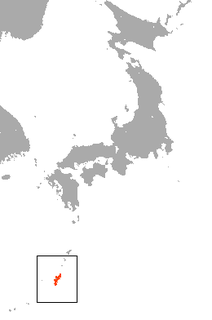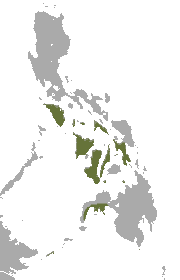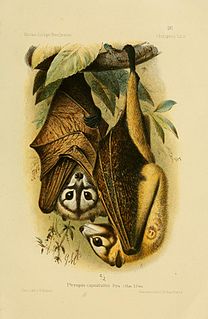
The Mariana fruit bat, also known as the Mariana flying fox, and the fanihi in Chamorro, is a megabat found only in the Mariana Islands and Ulithi. Habitat loss has driven it to endangered status, and it is listed as threatened by the US Fish and Wildlife Service. Poachers and food hunters, other animals, and natural causes have led to the decline.

The Aldabra flying fox is a species of megabat in the genus Pteropus. It is endemic to the Aldabra Atoll in the Seychelles, like Chaerephon pusilla, though the latter may be the same species as the little free-tailed bat.

The gray flying fox is a species of flying fox in the family Pteropodidae. It is not to be confused with the grey flying fox. It is found in Indonesia, but not in the Philippines, despite occasional reference to such. Very little is known about this species. The gray flying fox has small size and neutral coloration with a brownish head and an orange abdomen. It probably roosts individually or in small groups. It was listed on appendix II of CITES, and is classified as "Data Deficient" by the IUCN. This species has been decimated by hunting for bushmeat in Indonesia. The hunters use fishing hooks, ropes, and other supplies to hunt the bats. The ropes and hooks are placed along their flight paths, tearing and ensnaring the bats' wings when are flying. In the course of a hunting season, entire colonies can be killed.

The Lombok flying fox is a species of megabat in the genus Pteropus. It is endemic to Indonesia. This species has been listed on Appendix II of CITES since 1990, along with most others in the genus Pteropus. It was classified as "Least Concern" by the IUCN in 1996, but was changed to "Data Deficient" in 2008 due to uncertainty of the abundance and possible threats from hunting and habitat destruction.

The Okinawa flying fox is a species of megabat in the genus Pteropus. It is endemic to possibly Japan. It was previously listed as extinct by the IUCN, but because the two known specimens are taxonomically uncertain and of unknown provenance, it was changed to 'Data Deficient'. Some place this animal into synonymy under Pteropus mariannus. Two specimens are in the British Natural History Museum, and the whereabouts of the third is unknown. Two of the specimens are believed to have come from Southeast Asia, so the true distribution of the Okinawa flying fox is unknown.

The black-eared flying fox, species Pteropus melanotus, is a bat of the family Pteropodidae (megabats). Also known as Blyth's flying fox, it is found on the Andaman Islands and Nicobar Islands (India), and in Sumatra (Indonesia). A population on Christmas Island, which is critically endangered, has been placed as a subspecies of this population. The conservation and taxonomic status of that population was later re-established as a distinct species, the Christmas Island fruit-bat Pteropus natalis.

The Caroline flying fox or Pohnpei flying fox is a species of megabat in the genus Pteropus, endemic to Micronesia. Its natural habitat is subtropical or tropical dry forests. Prior to a ban on commercial exploitation, it was hunted for export, substantially impacting its abundance. It is threatened by habitat loss due to expanding plantations.

The great flying fox, also known as the greater flying fox or Bismarck flying fox, is a species of megabat in the genus Pteropus, found throughout lowland areas of New Guinea and in the Bismarck Archipelago. Conflicting evidence suggests that its closest relative is either the spectacled flying fox or, jointly, the Pelew and insular flying foxes. Two subspecies are recognized. At up to 1.6 kg (3.5 lb) in weight, it is among the heaviest bats in the world and the largest bat in Melanesia. It is a gregarious animal which roosts with hundreds or thousands of individuals. In part due to its wide variation in color, it has many taxonomic synonyms, including Pteropus degener, Pteropus papuanus, and Pteropus sepikensis. It may forage during the day or night in search of fruit, including figs or fruits from the family Sapotaceae. It is considered a least-concern species by the IUCN, though its numbers have been negatively impacted by what appeared to be a disease, as well as by hunting for bushmeat that occurs across its range.

The Ceram fruit bat or Seram flying fox is a species of megabat in the family Pteropodidae. It is endemic to the mountainous forests of two Maluku islands, Buru and Seram, including the Manusela National Park on Seram. They were once present on the nearby Ambon Island, but probably not anymore. The habitat has an area of less than 20,000 km2, and is decreasing due to logging. For this reason, and because of hunting by the local population, these species are listed as vulnerable by the IUCN since 1996.

Pteropus pelagicus is a species of fruit bat in the family Pteropodidae. It includes two subspecies that were formerly recognized as full species— Pteropus insularis and Pteropus phaeocephalus. It is endemic to Micronesia. It is threatened by habitat loss.

The little golden-mantled flying fox is a species of bat in the family Pteropodidae. It is found in Indonesia and the Philippines. Its natural habitat is subtropical or tropical dry forests.

The insular flying fox or Pacific flying fox is a species of flying fox in the family Pteropodidae. It is geographically widespread, the most widespread flying fox in the Pacific: it is found in American Samoa, the Cook Islands, Fiji, New Caledonia, Niue, Papua New Guinea, Samoa, the Solomon Islands, Tonga, and Vanuatu.

The Vanikoro flying fox, also known locally as the basapine, is a species of bat in the family Pteropodidae. It has only been found in the Vanikoro island group located in the southern Solomon Islands. The species as a whole was originally known from just a few specimens collected sometime before 1930 but following surveys conducted on the island in the early 1990s did not detect this species again causing the Vanikoro flying fox to be listed as extinct. However, the species was rediscovered by a survey conducted in late 2014 which indicated a population in the high hundreds or low thousands and reported all observations.

The Aru flying fox is a Critically Endangered species of megabat found in the Aru Islands in Indonesia. It was described by Wilhelm Peters in 1867. It was formerly considered a subspecies of the black-bearded flying fox. The species is poorly known, and has not been encountered since the 19th century. It is classified as critically endangered by the IUCN and is listed on CITES appendix II.

The Bismarck masked flying fox is a species of flying fox in the family Pteropodidae found in Papua New Guinea and named after the Bismarck Archipelago. It was once considered a subspecies of Pteropus temminckii before being reassessed in 2001. This species has two subspecies, P. c. capistratus and P. c. ennisae. The IUCN classified it as Near Threatened in 2009, noting that the rate of decline is almost high enough to reclassify the species as Vulnerable.

Andersen's flying fox is a species of flying fox in the family Pteropodidae found in south Burma and west Thailand. Although it is hunted for both food and as a pest, it is not known if this has a significant impact on the species. It has been seen roosting in tall, well-established trees in urban areas and will fly several kilometres to eat wild and cultivated fruits. The species was named after Knud Christian Andersen. It was last recorded in Thailand in 1970 and, presumably, there is still a small viable population in Myanmar.

The Kei flying fox is a species of megabat in the genus Pteropus found in the Kai Islands of Indonesia. It was formerly considered a subspecies of the black-bearded flying fox. Very little is known about the species, its habitat, or threats to it.

The Pelew flying fox is a species of megabat in the genus Pteropus found in the Palau Islands. A subspecies found on Yap, the Yap flying fox, is considered as a separate species by some authorities. The species is listed as vulnerable by the IUCN due to commercial and small-scale hunting; commercial hunting for the species was banned in 1994, but local exploitation is commonplace. The species is listed on CITES appendix I.




















